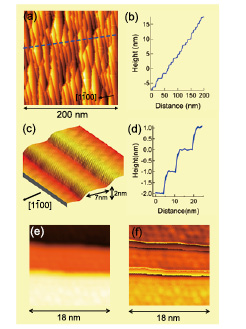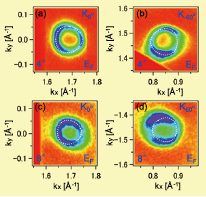Uniaxial Deformation of Graphene Dirac Cone on a Vicinal SiC Substrate
S. Tanaka and F. Komori
Modification of gapless graphene Dirac band has been widely investigated for understanding electronic properties characteristic to their chiral nature and for their useful applications. In the case of graphene on substrates, its electronic states can be changed by controlling the substrate nanostructure. We have studied the electronic states of graphene grown on the SiC(0001) substrates with step-and-terrace structures using angle-resolved photoemission spectroscopy (ARPES). On this substrate, high-quality graphene is prepared by thermal decomposition, and covers the whole surface continuously including the step edges. We found that the Dirac band is uniaxially deformed in the wave-number space for the substrate with narrow terraces. This is consistent with theoretical results that the group velocity of the Dirac electrons can be tuned anisotropically by external potentials in a nanometer scale [1,2].
 Fig. 1. Results of STM observations for the graphene grown on the 8º-off SiC(0001) substrate tiling toward [
Fig. 1. Results of STM observations for the graphene grown on the 8º-off SiC(0001) substrate tiling toward [

Fig. 2. Constant-energy ARPES intensity maps at EF for the graphene samples formed on the 4º- (a,b) and 8º-off (c,d) substrates around K0° (a,c), K-60° (b), and K60° (d). Here 0 degree indicates the [![]() ] direction. Dotted curves represent the constant-energy ideal band shape including the trigonal warping for flat graphene. The observed shape of the Dirac band for the 4º-off substrate is consistent with the ideal graphene while that for the 8º-off substrate is elongated in the [
] direction. Dotted curves represent the constant-energy ideal band shape including the trigonal warping for flat graphene. The observed shape of the Dirac band for the 4º-off substrate is consistent with the ideal graphene while that for the 8º-off substrate is elongated in the [![]() ] direction.
] direction.
Single-layer graphene was made by annealing Si-terminated surfaces of nitrogen-doped 6H- and 4H-SiC(0001) substrates vicinal to the [![]() ] direction. The
tilting angle was either 4 (6H) or 8 (4H) degree. The terraces are elongated in the direction perpendicular to [
] direction. The
tilting angle was either 4 (6H) or 8 (4H) degree. The terraces are elongated in the direction perpendicular to [![]() ] as confirmed by scanning probe microscopes. The terrace widths in the [
] as confirmed by scanning probe microscopes. The terrace widths in the [![]() ] direction were 21 and 9 nm on average for the 4º- and 8º-off substrates, respectively, while the width perpendicular to the [
] direction were 21 and 9 nm on average for the 4º- and 8º-off substrates, respectively, while the width perpendicular to the [![]() ] direction was commonly 100 nm. Figure 1 shows the results of the STM observation at 80 K for the graphene on the 8º-off substrate. The graphene at the substrate step edge is curved as observed by STM, and connects the flat graphene on the adjacent terraces. Namely, the present system consists of flat graphene on the terrace and curved one in the vicinity of the step edges. Electrons in the Dirac band on the terrace are scattered at the curved area of graphene as previously confirmed. [3]
] direction was commonly 100 nm. Figure 1 shows the results of the STM observation at 80 K for the graphene on the 8º-off substrate. The graphene at the substrate step edge is curved as observed by STM, and connects the flat graphene on the adjacent terraces. Namely, the present system consists of flat graphene on the terrace and curved one in the vicinity of the step edges. Electrons in the Dirac band on the terrace are scattered at the curved area of graphene as previously confirmed. [3]
The shapes of the graphene π and π* bands were studied using ARPES. The Dirac point was 0.4 eV below Fermi energy EF because of the doping from the substrate as in the case of the flat SiC substrate. For the graphene on the 4º-off substrate, the observed constant-energy ARPES intensity maps indicate trigonally-warped π and π* bands, and agree with the previous results. In contrast, the bands for the 8º-off substrate are significantly elongated in the [1-100] direction. Figure 2 shows the comparison of the band shapes at EF. The group velocity of the π* band in the Γ-K direction parallel to [![]() ] for the 8º-off substrate is more than 15 % lower than the velocity in the other Γ-K directions. The velocity significantly reduces only in the direction parallel to the substrate slope consistently with the theoretical prediction due to deformation of graphene [2].
] for the 8º-off substrate is more than 15 % lower than the velocity in the other Γ-K directions. The velocity significantly reduces only in the direction parallel to the substrate slope consistently with the theoretical prediction due to deformation of graphene [2].
References
- [1] C.-H. Park et. al., Nat. Phys. 4, 213 (2008).
- [2] S. Okada and T. Kawai, Jpn. J. Appl. Phys. 51, 02BN05 (2012).
- [3] K. Nakatsuji et. al., Phys. Rev. B 82, 045428 (2010).
